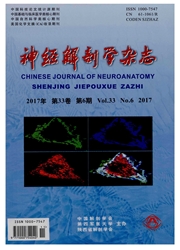

 中文摘要:
中文摘要:
目的:研究引起晕动病发生的双轴旋转运动刺激前庭感受器后,中央杏仁核神经元电学反应的变化,探讨中央杏仁核在晕动病(MS)发病中的作用.方法:10只幼年SD大鼠分成两组:对照组和旋转刺激组.旋转刺激组动物经2h双轴旋转运动刺激(大、小转盘分别以168°/s和432°/s的角速度旋转).取脑、切片(300μm),应用脑片膜片钳全细胞记录技术记录中央杏仁核神经元膜的主动反应特性以及自发的兴奋性突触后电流(sEPSCs)变化,统计分析、比较两组间的差异.结果:旋转运动刺激后,中央杏仁核神经元电学特性,如膜电位水平(对照组为(-62.80±2.69) mV,旋转组为(-61.37±1.50) mV)以及动作电位(AP)形态未发生显著变化.AP的幅值、半幅时程、最大上升/下降斜率、刺激阈电位和基强度等在两组间没有显著性差别;旋转刺激后,sEPSCs频率从正常组的(0.88 ±0.42) Hz增加到旋转组的(1.69 ±0.30)Hz(P<0.05)而幅值(正常组(20.07±3.01)pA;旋转组(21.03 ±1.44) pA)未发生变化.结论:引发晕动病的运动刺激可引起中央杏仁核神经元兴奋性突触活动增加,突触前谷氨酸释放增加;中央杏仁核参与晕动病反应.
 英文摘要:
英文摘要:
Objective: To investigate the electrophysiological properties of neurons in nucleus of central amygdala (CeA) of rat following motion sickness (MS) induced by double rotation to stimulate the vestibular end organ and to explore the role of CeA in genesis of MS. Methods : Ten young Sprague-Dawley ( SD ) rats were equally divided into two groups, i.e. control and rotation stimulation groups. Animals in the rotation group were subjected to double-axes rotation for 2 h with angular velocity of 168~/s and 432~/s for large and small rotation discs, respectively. The animals' brains of both groups were removed and cut into coronal slices of 300 Ixm thick. The membrane active properties and spontaneous excitatory postsynaptie currents (sEPSCs) were recorded with patch-clamp technique in whole cell mode. The measurements were finally analyzed and were statistically compared between two groups. Results: The eleetrophysiologieal properties of CeA neurons such as membrane potential ( - 62.80 ± 2.69 mV vs - 61.37 ± 1.50 mV for control and rotation groups, respectively. ) and profiles of action potential (AP) showed no change post rotation stimulation. The amplitude, half width, maximum rise/decay slope, threshold potential and stimulating rheobase of AP demonstrated no significant difference. Following rotation, the frequency of sEPSCs increased significantly ( 0.88± 0.42 Hz vs 1.69 ± 0.30 Hz for control and rotation groups, respectively. ) (P 〈0.05), while the amplitude of sEPSCs (20.07 ± 3.01 pAvs 21.03 ± 1.44 pA for control and rotation groups, respectively. ) showed no change. Conclusion : The stimulation via MS-inducing motion increases the activities of excitatory synapses and the presynaptic release of glutamate in nucleus of the central amygdala, and CeA participates in the responses of motion sickness.
 同期刊论文项目
同期刊论文项目
 同项目期刊论文
同项目期刊论文
 期刊信息
期刊信息
